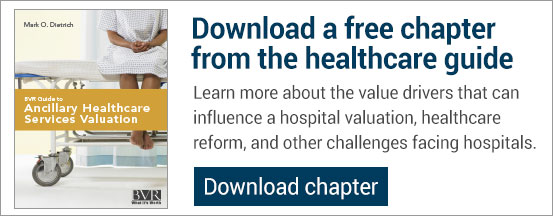Five Hospital Value Drivers That Can Influence a Valuation
Many factors can influence the value of a hospital. It is imperative that a business appraiser undertaking these complex assignments is both mindful and understanding of the unique circumstances and nuances inherent in valuation within this industry in order to generate a sound opinion of value.
In BVR’s publication, Guide to Ancillary Healthcare Services Valuation, contributors G. Don Barbo and Robert M. Mundy cover several examples of hospital value drivers that an appraiser should understand before tackling these types of engagements.
1. Location and Demographics of the Community
Similar to the real estate market, a hospital’s location can have a significant impact on its value. Numerous aspects of a hospital’s operations will be impacted by its location, such as its admission patterns, payer mix, and workforce. A hospital located near a major highway or in a highly populated area will tend to have high patient volumes. Rural hospitals may face difficulty in attracting and retaining physicians, particularly specialized physicians and surgeons.
Local community demographics can also significantly impact a hospital’s value. Hospitals operating in an area with a large percentage of the population over 65 years of age may have a greater demand for its services than a similar hospital located in a college town with a younger population. A hospital operating in a lower socio-economic area will tend to have higher levels of Medicaid or uninsured patients.
2. Age and Appearance of the Facility
A hospital’s age and appearance can significantly impact patient volumes, as patients and physicians prefer newer, modernized facilities. Hospitals are moving away from the older institutionalized construction toward a warmer and inviting “home-like” experience.

Additionally, hospitals are focusing on providing convenient patient care by investing in ambulatory care settings and delivering services into the community rather than adding new inpatient beds. The shifting of patient volumes from inpatient to outpatient settings has been a developing trend for a number of years, and the Affordable Care Act’s emphasis on population health management and the medical home concept escalated this outpatient shift. As such, hospitals have focused new construction efforts on urgent care and primary care clinics to improve patient convenience and strengthen physician alliances.
3. Medical Staff Composition
Coordinated relationships with physicians in the community are integral to the success of a hospital. In past years, hospitals have concentrated their physician alignment strategies on direct employment of physicians. Recently, however, alignment strategies have become especially nuanced, including a variety of models such as:
- Co-management agreements;
- Professional service agreements;
- Clinically integrated networks; and
- Accountable care organizations (ACOs).
With the shift from fee-for-service models to value-based healthcare, a hospital’s physician alignment strategy needs to be consistent with its overall mission and strategic plans.
4. Competition
As with any other business, the level of competition in the market area will generally have a material impact on a hospital’s value. In recent years, hospitals have faced competition from not only other hospitals, but also other facilities such as ambulatory surgery centers (ASCs).

Because ASCs only provide day surgery services, they are much smaller than general hospitals and offer a much broader range of medical services. Plus, they are able to operate with a smaller staff and lower overhead levels. Due to their focus on select types of surgeries, ASCs typically offer the following benefits over hospitals:
- Patients are less at risk of being bumped or losing their scheduled surgery to more critical cases, as may often occur in a hospital setting;
- Because of their lower operating cost structure and efficient operating environment, managed care companies and insurance companies look favorably on ASCs and can often negotiate lower payments with ASCs for these medical services;
- Physicians are able to schedule their surgery cases in advance with less risk of being bumped;
- The nursing staff is familiar and well-trained in supporting the surgeries performed in the ASC; and
- Because of their focus on day surgeries, ASCs can draw less urgent cases from the hospitals, allowing hospitals to treat the more serious and traumatic cases.
5. Contracting Strength
A hospital’s ability to negotiate and secure favorable reimbursement contracts with third-party commercial payers will generally have a positive impact on its profitability and value. Many small community hospitals have partnered or affiliated with larger healthcare systems in an attempt to garner more lucrative payer contracts. Typically, hospitals or health systems with a large presence in a market area can negotiate better commercial insurance rates than smaller hospitals. An appraiser attempting to value a hospital needs to understand the local commercial insurance market, the major commercial insurers within the community, and the hospital’s leverage with these payers.
Conclusion
While we’ve covered some of the key value drivers for valuing a hospital, the more an appraiser can develop an understanding of the hospital industry, the more sound opinion of value he or she can render. All hospitals and the communities in which they operate have unique characteristics that must be examined and properly considered.
To expand your knowledge before performing one of these complex engagements, download a free chapter from the Guide to Ancillary Healthcare Services Valuation, that covers not only the top value drivers, but also healthcare reform, current challenges facing hospitals, the valuation process, and more.

